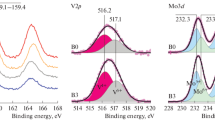Abstract
The catalytic properties of a Sn/V/Sb mixed oxide for propane ammoxidation to acrylonitrile are studied in this paper. In particular the antimony and vanadium amounts were changed in order to optimize the relative atomic ratio. The ternary sample with the best catalytic performance was compared with the analogous binary samples (Sn/Sb and Sb/V). The results obtained indicate that vanadium is responsible for the paraffin activation, nevertheless much vanadium produces a lot of carbon oxides. Antimony is responsible for the insertion of nitrogen in the molecule (it can be considered as an acrylonitrile selectivity modulator); nevertheless, too much antimony deactivates the catalyst. Tin does not act only as a dispersive matrix for the active sites, but leads to the formation of a polyfunctional catalyst, increasing the rate of acrylonitrile formation from the intermediate propene. From a structural point of view, this catalytic system can be described as a homogeneous system, containing microfields of rutile type oxide (SnO2), promoted with antimony and vanadium in substitutional solid solution, dispersed in an excess of amorphous antimony oxide.
Similar content being viewed by others
Rights and permissions
About this article
Cite this article
Albonetti, S., Blanchard, G., Burattin, P. et al. A new ternary mixed oxide catalyst for ammoxidation of propane: Sn/V/Sb. Catalysis Letters 50, 17–23 (1998). https://doi.org/10.1023/A:1019046430749
Issue Date:
DOI: https://doi.org/10.1023/A:1019046430749




